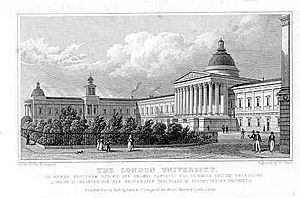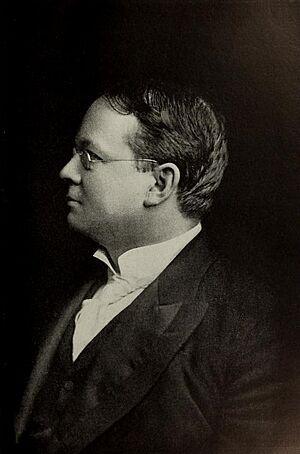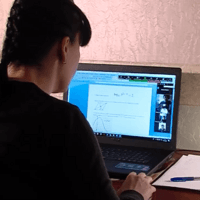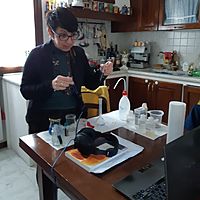Distance education facts for kids
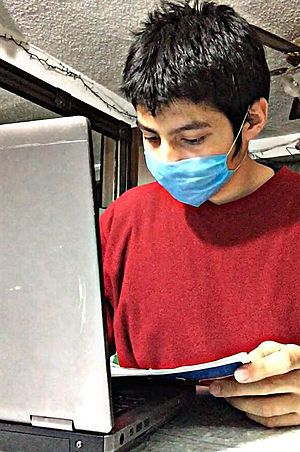
Distance education (also called distance learning) is a way of learning where the teacher and students are not in the same place. This means that teaching happens through different tools. These can include books, movies, TV, radio, video calls, and websites.
In 1840, Isaac Pitman started teaching his shorthand writing method. He did this by sending and receiving postcards. His success led to the creation of schools that taught by mail.
Contents
Early University Courses by Mail
The University of London was the first university to offer degrees through distance learning. They started their External Programme in 1858. This was a big step because it allowed more people to get a university education.
At that time, there were arguments about which schools could give out degrees. A solution was found in 1836. A new "University of London" was created. It would be in charge of giving exams and awarding degrees. This meant that teaching and testing could be done by different groups.
This new system made it possible for the university to offer programs. Students could study on their own or at other schools. Then they could take exams and get degrees from the University of London.
Charles Dickens called this program the "People's University." This was because it helped students from less wealthy families get a higher education. Queen Victoria officially approved the External Programme in 1858. This made the University of London the first to offer distance learning degrees. More and more students joined in the late 1800s. Many other universities copied this idea. Today, this program is called the University of London International Programme. It offers many types of degrees.
In the United States, William Rainey Harper was the first president of the University of Chicago. He supported the idea of education reaching beyond the main campus.
In 1892, Harper encouraged universities to offer courses by mail. By the 1920s, many universities, like Chicago and Columbia, were doing this. The International Correspondence Schools in Pennsylvania grew very quickly. It started in 1888 to train coal miners. By 1906, nearly a million students had signed up. They sent out full textbooks and had many salespeople.
These schools focused on teaching specific skills. They were different from traditional colleges. Colleges aimed to give a broad education. Correspondence schools helped students learn exactly what they needed for a certain job.
During the Progressive Era, education became very important in America. High schools and colleges grew a lot. Night schools opened for older people or those with jobs. The YMCA school in Boston, which became Northeastern University, is an example. Outside big cities, private mail-based schools offered flexible training. Large companies also started training programs for their new workers.
By 1920, many Americans lived outside big cities. Distance learning helped reach them. Australia, with its huge distances, was very active in this. The University of Queensland started its distance learning department in 1911. In South Africa, the University of South Africa began offering distance education in 1946. The first international meeting for correspondence education was in 1938. Its goal was to offer personalized education at a low cost. This group is now called the International Council for Open and Distance Education (ICDE).
Open Universities
The Open University in the United Kingdom was started by the government in the 1960s. Prime Minister Harold Wilson and Michael Young had a vision for it. Jennie Lee helped plan it. She wanted the Open University (OU) to make higher education available to more people. The British Broadcasting Corporation (BBC) helped by broadcasting teaching programs on TV.
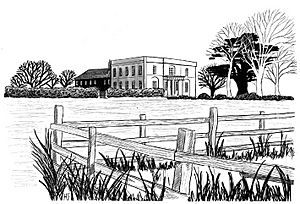
The Open University changed how distance learning worked. It became a respected way to learn, different from traditional schools. It has used new technologies to improve distance learning. Walter Perry became the OU's first leader in 1969. The OU welcomed its first 25,000 students in 1971. It had an "open admissions" policy, meaning almost anyone could join. At that time, only about 130,000 students were in regular UK universities.
Athabasca University in Canada started in 1970. It followed a similar path. The Open University inspired other countries to create similar schools. Spain's National University of Distance Education (1972) and Germany's FernUniversität in Hagen (1974) are examples. Today, many "Open Universities" exist worldwide.
The University of the Philippines Open University began in 1995. It was the first online university in the Philippines. Its goal is to give education to people who want to learn more. This includes those who cannot attend traditional schools because of work or family.
Most open universities use distance learning tools. Some might ask students to visit local study centers or attend "summer schools." Some have grown very large, with over 100,000 students. These are sometimes called mega-universities.
COVID-19 Pandemic
The COVID-19 pandemic caused most schools around the world to close. Many schools switched to online learning. They used platforms like Zoom, Google Meet, and Microsoft Teams.
There were worries about students who did not have internet access or devices. Distance education during the pandemic also made it hard for some teachers and students to learn together in real time. This is called "synchronous learning." When teachers could only give lessons that students did on their own time (asynchronous), it was harder for everyone to adjust.
A study found that students had trouble creating their own work online. It suggested teachers should give less information. They should also add more activities to lessons. This helps students be more active in their learning.
The Internet's Role
The widespread use of computers and the internet has made distance learning much easier. Today, virtual schools and virtual universities offer full courses online. The internet can handle voice, video, text, and interactive lessons. This has combined many older ways of learning, like phone calls, video calls, radio, TV, and text. However, many good ideas from those older methods are still used online.
The first online course for university credit was offered in 1984. It was by the University of Toronto. The course was about "Women and Computers in Education." The first university that was completely online started in 1994. It was the Open University of Catalonia in Spain. In 1999, Jones International University became the first fully online university in the US to be officially recognized.
Between 2000 and 2008, more and more people signed up for distance education. This happened in almost every country. Many schools and universities now offer online courses. These range from basic lessons to advanced degrees. For example, New York University offers online degrees in engineering.
The quality of online schools can vary. Well-known universities like Stanford and Harvard now offer online courses. But some online schools are not well-supervised. Some are even fake, called diploma mills. In the US, the Distance Education Accrediting Commission (DEAC) checks the quality of distance learning schools.
In 2011, about one-third of all college students in the United States had taken an online course. This number kept growing. By 2013, most public and private colleges offered full online programs. These included training in fields like occupational therapy and rehabilitation counseling.
By 2008, online learning programs were available for students from kindergarten to 12th grade in 44 US states.
Online forums, discussion groups, and learning communities can help with distance education. Research shows that connecting with others is important in some types of distance learning.
Related pages
Images for kids
-
A student in Kerala, India, learning from home during the COVID-19 pandemic.
See also
 In Spanish: Educación a distancia para niños
In Spanish: Educación a distancia para niños


